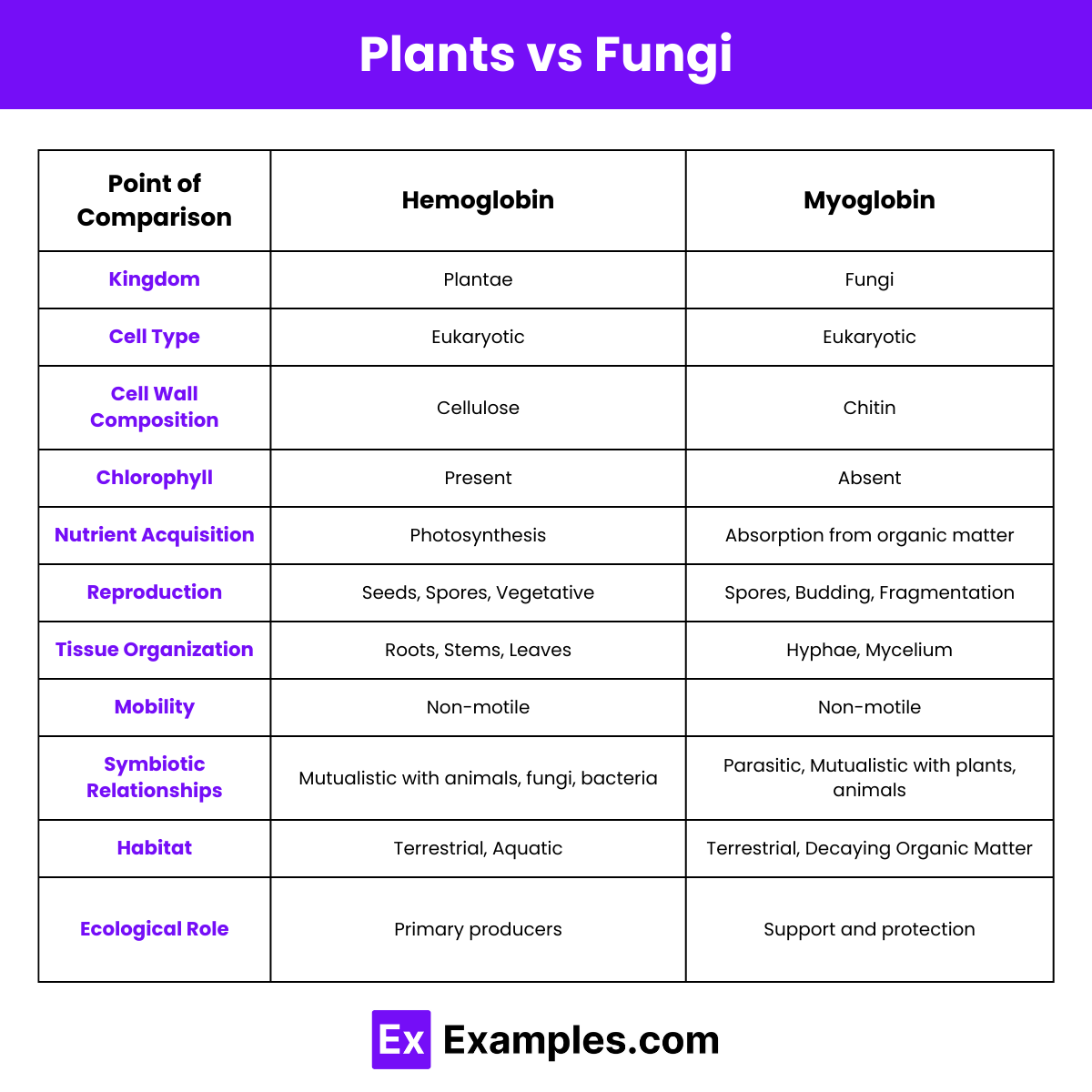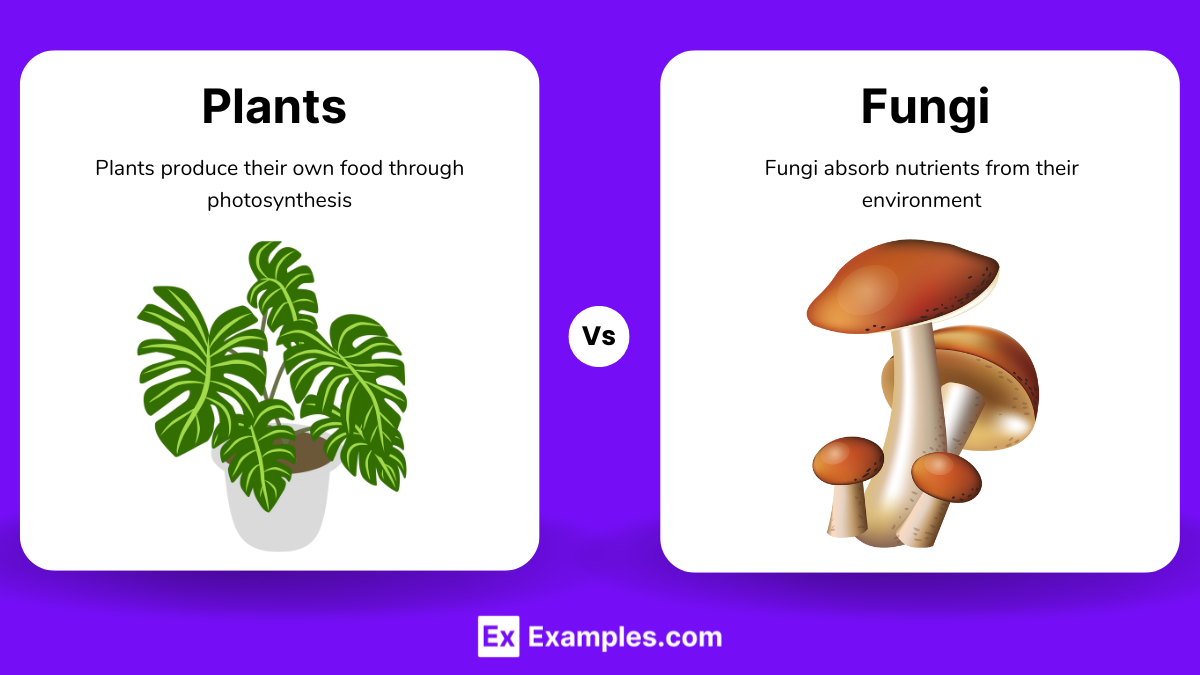Plants vs Fungi – Differences Explained with Examples & Classifications
Plants and fungi, two fundamental kingdoms of life, exhibit remarkable differences and surprising similarities. This article explores the distinct characteristics of plants and fungi, shedding light on their unique biological processes, ecological roles, and evolutionary paths. By comparing their cellular structures, methods of reproduction, and mechanisms of nutrient acquisition, we gain deeper insights into how these organisms thrive and interact with their environments. As we delve into the fascinating dynamics of plants versus fungi, we uncover the critical roles they play in sustaining biodiversity and ecological balance.
What are Plants?
Plants are a large and diverse group of organisms that belong to the kingdom Plantae. They are primarily characterized by their ability to perform photosynthesis, the process of converting light energy into chemical energy. This ability is facilitated by chlorophyll, a green pigment found in their cells.
Classification of Plants
Plants are classified into several groups, but the major divisions include:
- Algae: These are typically aquatic plants, ranging from single-celled organisms like Chlorella to large seaweeds like kelp.
- Bryophytes: This group includes mosses, liverworts, and hornworts. These plants do not have vascular tissue and are usually found in moist environments.
- Ferns and Lycophytes: These are vascular plants that reproduce via spores rather than seeds.
- Seed Plants: This group includes gymnosperms (like pine trees and cycads) and angiosperms (flowering plants). Seed plants have a wide range of forms and are the most diverse and numerous plants on Earth.
Importance of Plants
Plants play several crucial roles in the environment and for human life:
- Oxygen Production: Through photosynthesis, plants produce oxygen, which is essential for the survival of most life forms on Earth.
- Food Source: Plants are a primary source of food for many organisms, including humans. They form the base of most food chains.
- Habitat: Many organisms depend on plants for habitat and shelter.
- Medicinal Uses: A significant portion of medicines are derived directly or indirectly from plants.
- Environmental Impact: Plants influence and stabilize the Earth’s environment. They can help control temperatures, reduce erosion, and influence water cycles.
Challenges Facing Plants
Despite their importance, plants face numerous challenges:
- Climate Change: Changes in temperature and weather patterns can affect plant growth and survival.
- Deforestation: The removal of trees and forests for agriculture or urban development reduces biodiversity and disrupts ecosystems.
- Pollution: Air, water, and soil pollution can negatively affect plant health and productivity.
- Invasive Species: Non-native plants can outcompete native species, leading to reduced biodiversity.
What are Fungi?
Fungi are a distinct kingdom of organisms that are neither plants nor animals. They include yeasts, molds, and mushrooms. Unlike plants, fungi do not perform photosynthesis; instead, they absorb nutrients from their environment, often by decomposing organic matter.
Classification of Fungi
Fungi are classified into several major groups based on their life cycles and reproductive structures:
- Chytridiomycota (Chytrids): These are primarily aquatic fungi and some of the simplest types.
- Zygomycota (Zygote fungi): This group includes molds like Rhizopus, the black bread mold.
- Ascomycota (Sac fungi): Includes yeasts and molds such as Penicillium, as well as more complex forms like morels and truffles.
- Basidiomycota (Club fungi): Comprises familiar mushrooms, along with puffballs, rusts, and smuts.
Importance of Fungi
Fungi play crucial roles in various ecological and economic areas:
- Decomposers: They break down dead organic material, returning nutrients to the soil and aiding in the cycle of nutrients.
- Symbiotic Relationships: Many fungi form symbioses with plants, such as mycorrhizal associations, which enhance plant nutrient absorption.
- Food and Medicine: Some fungi are edible, like mushrooms, and others are used in the production of medicines, such as antibiotics.
- Industrial Applications: Fungi are used in the fermentation process to produce alcohol, bread, and cheeses.
Challenges Facing Fungi
- Environmental Changes: Changes in land use, climate change, and pollution can disrupt fungal populations and their habitats.
- Overharvesting: Some species, particularly medicinal and edible mushrooms, are at risk due to excessive collection and habitat loss.
- Disease: Fungi are also susceptible to diseases and pests, which can decimate populations.
Differences Between Plants and Fungi

| Feature | Plants | Fungi |
|---|---|---|
| Cell Structure | Cell walls made of cellulose. | Cell walls made of chitin. |
| Nutrition | Autotrophic, primarily through photosynthesis. | Heterotrophic, absorb nutrients from external sources. |
| Growth | Grow upwards, towards light. | Grow in all directions, often underground or on decaying matter. |
| Reproduction | Reproduce via seeds, spores, and vegetative means. | Primarily through spores, sometimes vegetatively. |
| Energy Source | Use sunlight to produce energy. | Break down organic material to release energy. |
| Chlorophyll Presence | Contain chlorophyll. | Lack chlorophyll. |
| Organ Organization | Complex, with organs such as leaves, stems, and roots. | Simpler, lacking true roots, stems, or leaves. |
| Habitat | Diverse habitats but typically in sunlight-exposed areas. | Often found in moist, dark environments. |
| Role in Ecosystem | Primary producers in ecosystems. | Decomposers, breaking down dead organic material. |
| Life Cycle | Defined life cycle stages (seed, growth, reproduction). | Life cycle can vary, often includes a mycelial stage. |
| Examples | Roses, oak trees, grasses. | Mushrooms, molds, yeast. |
| Economic Importance | Essential for food, medicine, and materials like wood and paper. | Important in decomposition, medicine (antibiotics), and food (cheese, bread). |
Similarities Between Plants and Fungi
Cellular Structure
Both plants and fungi are eukaryotic organisms, meaning their cells have a nucleus enclosed within membranes. Additionally, they both have cell walls, though the composition differs: plants primarily use cellulose, while fungi use chitin.
Growth and Development
Plants and fungi share similar growth patterns in that they both expand in size through cell enlargement and can develop complex structures as they grow. They both produce spores, which can be a method of reproduction, though the specific functions and structures of these spores can vary.
Ecological Roles
Both groups play essential roles in their ecosystems. Plants are typically primary producers, creating organic material through photosynthesis. Fungi, although primarily decomposers, breaking down organic material, can also form symbiotic relationships with plants, such as mycorrhizae, enhancing nutrient absorption for the plants.
Stationary Lifestyle
Plants and fungi are both sessile, meaning they do not move from place to place. They must adapt to their environment and utilize strategies like growing towards sources of nutrients or light (in the case of plants) to survive and reproduce.
What are the main differences between plants and fungi?
Plants perform photosynthesis, have roots, stems, and leaves, while fungi absorb nutrients from organic matter, lack chlorophyll, and have a network of hyphae.
Do fungi produce their own food?
No, fungi do not produce their own food. They absorb nutrients from organic matter, unlike plants that perform photosynthesis.
Can fungi and plants reproduce sexually and asexually?
Yes, both fungi and plants can reproduce sexually and asexually, utilizing various methods such as spores for fungi and seeds for plants.
Are fungi considered plants?
No, fungi are not considered plants. They belong to their own kingdom, Fungi, and have distinct biological characteristics.
What are the common uses of fungi?
Fungi are used in medicine (antibiotics), food production (yeast, mushrooms), and ecological processes like decomposing organic matter.
Do fungi have chlorophyll?
No, fungi lack chlorophyll and cannot perform photosynthesis. They obtain nutrients from organic matter.
How do plants and fungi contribute to the ecosystem?
Plants produce oxygen and food through photosynthesis, while fungi decompose organic matter and recycle nutrients.
Can fungi cause diseases in plants?
Yes, fungi can cause diseases in plants, leading to various plant infections and agricultural issues.
What are mycorrhizal fungi?
Mycorrhizal fungi form symbiotic relationships with plant roots, enhancing nutrient absorption for plants.



